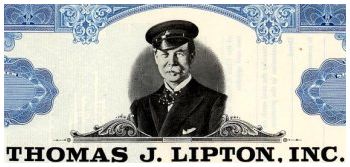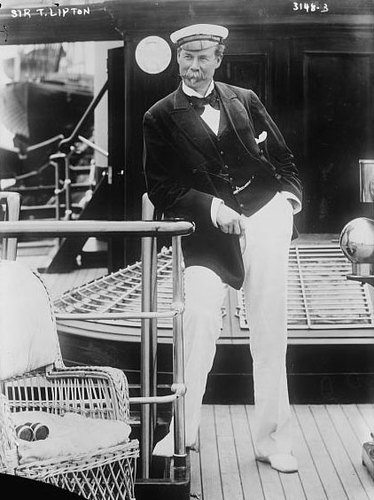Yves GARY Hits: 5145
Category: 1899 : CHALLENGE N°10
 It was feared by many that the Dunraven affair would result in a permanent cessation of contests for the America's cup, and such might have been the case had not Sir Thomas J. Lipton, an enterprising tradesman, profiting by an era of good feeling between the United States and Great Britain, issued a challenge through an Irish yacht club of which he was a valued member.
It was feared by many that the Dunraven affair would result in a permanent cessation of contests for the America's cup, and such might have been the case had not Sir Thomas J. Lipton, an enterprising tradesman, profiting by an era of good feeling between the United States and Great Britain, issued a challenge through an Irish yacht club of which he was a valued member.
British clubs showed a disposition to have no more of the cup, and Englishmen were not inclined at first to take Sir Thomas seriously as a yachtsman. He was not one of those patrician members of the Royal Yacht Squadron whose views on the ethics of sport had been given the New York Yacht Club in the deed of gift controversy, but the son of a laborer, of Scotch-Irish origin, to whom knighthood came after unprecedented donations to charities in the Queen's Jubilee year.
It was not in the mind of the New York Yacht Club to scrutinize the shield of Sir Thomas Lipton, however. A challenger whose money came from pork and tea was quite as acceptable to the club as one whose wealth was from ancestral estates; while Sir Thomas, despite his humble origin, was in high favor with the heir to the British throne.
|
Official notice of Sir Thomas' intention to challenge was received in August, 1898, in the following cable message: August 6th, 1898. |
In response to this communication the following cable message was sent by the New York Yacht Club: Hugh C. Kelly, |
The New York Yacht Club also passed the following resolution :
The Royal Ulster Yacht Club having communicated to this club its intention to challenge for the America's cup,
Resolved, That the flag officers, the secretary and treasurer be and they hereby are appointed a committee with power on behalf of the club
- to accept, under the deed of gift, such challenge for the America's cup,
- to arrange the terms thereof,
- to select a yacht to represent this club therein,
- and by mutual consent with the challenging club to make any such arrangements as to dates, courses, number of trials, rules and sailing regulations, and any and all other conditions of the match;
- and the said committee shall have power in their discretion to add to their number.
Said match shall be sailed under the direction of the regatta committee pursuant to article X. of the constitution.
 This last sentence might be deemed superfluous, since the regatta committee directs all races of the club, were it not for the fact that in the Dunraven affair the committee felt its powers were usurped to a considerable degree by the cup committee. The cup committee being a special committee, its duties are generally confined to matters pertaining to challenges for the cup. In the Dunraven case it made rulings, however, on questions in dispute arising from the races, as in the case of the foul, and of remeasurement of the yachts; and this the regatta committee felt was a usurpation of its own powers.
This last sentence might be deemed superfluous, since the regatta committee directs all races of the club, were it not for the fact that in the Dunraven affair the committee felt its powers were usurped to a considerable degree by the cup committee. The cup committee being a special committee, its duties are generally confined to matters pertaining to challenges for the cup. In the Dunraven case it made rulings, however, on questions in dispute arising from the races, as in the case of the foul, and of remeasurement of the yachts; and this the regatta committee felt was a usurpation of its own powers.
The cup committee organized in due form, with Commodore J. Pierpont Morgan as chairman, and named as additional members Ex-Commodores E. D. Morgan and Edward M. Brown, Gen. Charles J. Paine, and Herman B. Duryea. Gen. Paine later declined to serve, and Mr. Henry F. Lippitt was elected in his stead. The committee cabled the Royal Ulster Yacht Club, on August 11th :
"A challenge from your club will be most agreeable. Committee appointed with full power to act on challenge and arrange all details. Challenge to be binding and carry precedence must be accompanied by name of owner, and certificate, name, rig and dimensions of the challenging yacht as specified in Deed of Gift. Your committee will be warmly welcomed."
On September 3rd the special committee of the Royal Ulster Yacht Club was received. It consisted of Vice-Commodore R. G. Sharman-Crawford, Mr. H. M. McGildowny, and Hugh C. Kelly, honorable secretary. They were accompanied by Mr. William Fife, Jr., designer of the challenging boat, and Mr. Charles Russell, a friend of Sir Thomas Lipton. The committee presented the following challenge :
J. V. S. Oddie, EsqR., |
It will be observed that the only dimension given was load water-line, according to custom, and not "dimensions as specified in deed of gift," mentioned in the New York Yacht Club's letter of August 11th. The New York Yacht Club, by resolution, decided that the arrangements for the match be based upon the conditions "accorded to Charles D. Rose under his challenge of 1895 through the Royal Victoria Yacht Club." The negotiations between the committees of the Royal Ulster Yacht Club and the New York Yacht Club were brief and harmonious. The guarded attitude maintained by both sides in the Dunraven negotiations had given way to superlatively friendly intercourse. Sir Thomas Lipton asked little and conceded much, and therefore was considered an ideal challenger. The committee of the Royal Ulster Club before returning to Ireland subscribed on September 6th, 1898, to the conditions which should govern the match under their challenge. These provided for the best three out of five races, the first to be sailed October 3d, 1899; the first, third and fifth fifteen miles to windward or leeward and return, the second and fourth over a thirty-mile triangle; all starts to be from Sandy Hook light-vessel, to windward if possible; the time limit to be five and a half hours, and postponed races of one kind to be repeated until finished. Each vessel was to have time for repairs in case of accidents before the preparatory signal for a race. The measuring clause was the same as in the Dunraven conditions, with the marking provision included. |
